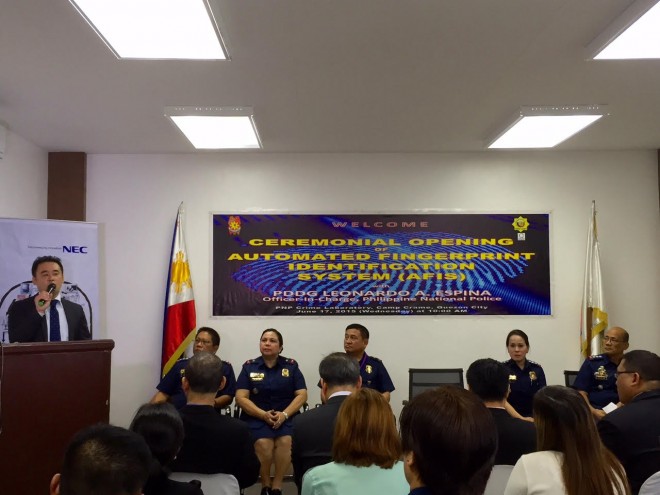
Newly-procured equipment of PNP Crime Laboratory that could store up to five million criminal and non-criminal records nationwide. JULLIANE LOVE DE JESUS
THE Crime Laboratory of the Philippine National Police has acquired a “high-tech” equipment expanding the database of criminals that could help speed up the solution of crimes nationwide.
The Automated Fingerprint Identification System was launched on Wednesday in a ceremony at Camp Crame. This is the second phase of the system improvement that will include the upgrading of the capacity of crime laboratory’s equipment and installation of additional workstation.
For the first phase, the government of Japan through Japan International Cooperation Agency (JICA) donated P500 million to the PNP for the installation of equipment that will be upgraded in the second phase. The new AFIS will be operational starting on Monday next week.
Chief Superintendent Augusto Marquez, deputy director of the Directorate for Investigation and Detection Management, said in an interview at Camp Crame that the newly-procured equipment will increase the PNP’s efficiency in crime solution and clearance.
As of June, the Crime Laboratory has more than 761,000 records in its system for the last five years. But before the system reaches its one-million record capacity, it will be increased to five million.
The P250-million worth project, according to Marquez, will expand the storage capacity of their equipment, from holding one million to five million criminal and non-criminal records.
Unlike before, it takes at least a week to establish the identity suspects or victims through cross-matching, now identification process can be finished within a few minutes.
“With AFIS, we can now search data from three million records in 60 seconds, meaning, we’ll be able to identify three million records in just one minute,” Superintendent Ariel Ayusip, chief of the Fingerprint Identification Division of PNP Crime Laboratory, told reporters.
Once the criminal is identified through AFIS, the crime laboratory will furnish the DIDM a copy of his records then the police station, which handles the case, will file charges against the suspect.
Biometrics scanner
Marquez said the PNP hopes to have all 1,766 police stations across the country equipped with a biometrics scanner, scrapping the old process of taking finger prints.
“This way, fingerprinting will not be done on a carton or paper. Fingers would be scanned in a device the size of a smartphone,” Marquez explained.
When police make arrests, suspects undergo a booking process including the taking of fingerprints. Collected fingerprints of suspects who have been identified by police are called “ten-prints,” which shows ten fingerprint impressions. As for the invisible fingerprints taken in crime scenes, these are called “latent prints.”
Once the person undergoes scanning, his or her fingerprints will immediately be saved in the database, allowing the Crime Laboratory headquarters to access the data.
“Let’s say if the police will retrieve a suspect’s ten-print in Basilan, instantly, the data can be accessed here in Camp Crame. Unlike before that fingerprints on papers, which sometimes have smudges, will have to be transported here,” he said.
“So when we request for another copy of the fingerprints, the suspect is already released on bail, which means that case is unsolved because of the lack of evidence,” he added.

